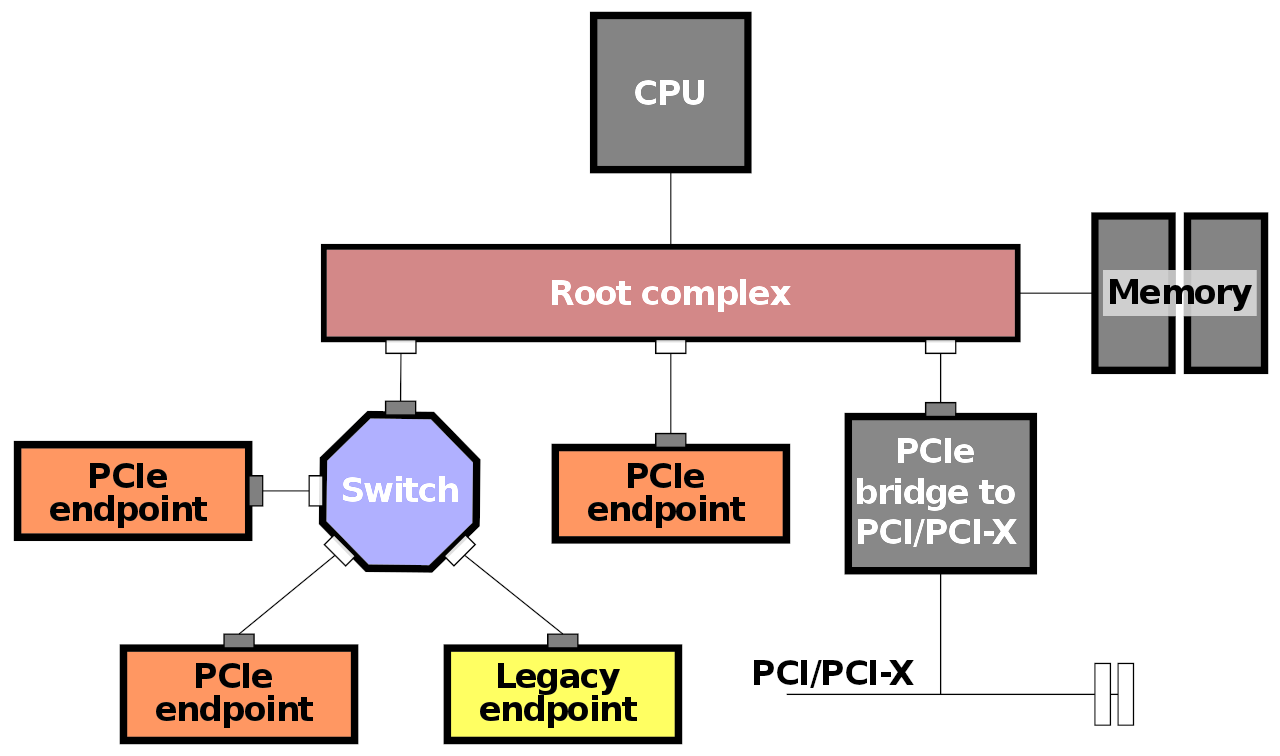PCI Express¶
PCIe is based on point-to-point topology. Devices are connected to the root complex (PCIe host) through separate full-duplex serial links. If PCIe devices are not directly connected to the root complex, they can be indirectly connected through a PCIe switch.

Figure 1 PCI Express topology. Mliu92 CC BY-SA 4.0¶
Physical Layer¶
Note
The Warp Pipe emulation PCIe communication library will not have to concern itself with the PHY layer. Please treat this section as a supplementary one.
System Management Bus (SMBus) is used for controlling and managing PCIe devices. It is interoperable, to some extent, with I2C. PCIe uses serial interface.
The standard way to declare how many datalanes are supported is by the nx
notation, e.g. 1x supports one data lane, 2x - two data lanes, and 4x - four
data lanes. Data lanes use Low Voltage Differential Signaling (LVDS).
Mechanical key notch is used to separate control and power pins from data pins.
PCIe uses 8b/10b encoding (<3.0) or 128b/130b (3.0 onwards). Data clock is embedded in the serial signal. Interrupts are signalled through Message Signaled Interrupts (MSI). MSI-X are used in PCIe 3.0 onwards.
Data Link Layer¶
Data link layer packets (DLLPs) can be divided into four categories:
ACK DLLPs - for acknowledging that Transaction Layer Packet (TLP) was successfully received
NAK DLLPs - for informing that the TLP was corrupted or that timeout occurred
Flow control (FC) DLLPs - used to announce credits
Power management DLLPs
Note
Warp Pipe will not have to handle power management DLPPs, as the assumption is that all PCIe devices will be emulated.
The FC mechanism accounts for 6 buffer consumers (credit types):
Posted Requests TLP headers
Posted Requests TLP data
Non-Posted Requests TLP headers
Non-Posted Requests TLP data
Completion TLP headers
Completion TLP data
Transaction Layer¶
Transaction Layer Packets (TLPs) carry the actual read/write operation requests to/from a PCIe device.
TLPs may target one of the following address spaces:
Memory
IO
Configuration
Message
Transactions can be “posted” or “non-posted”, which indicates if a request requires a completion or not.
Posted transactions, namely memory writes and messages, are considered “finished” by the issuer as soon as they are sent, which has the potential of increasing the performance of the system.
Completion messages, indicating if the transaction is finished, may or may not contain data.